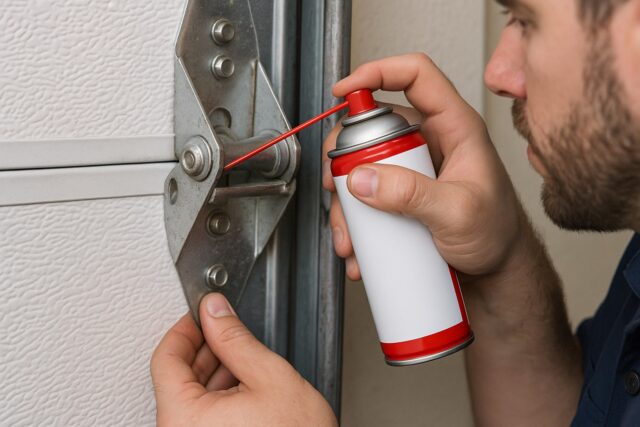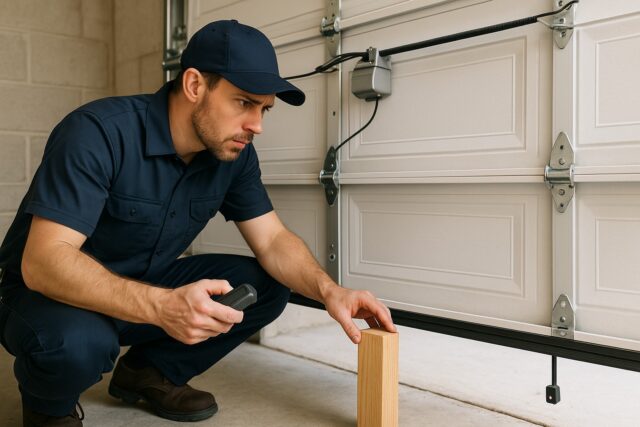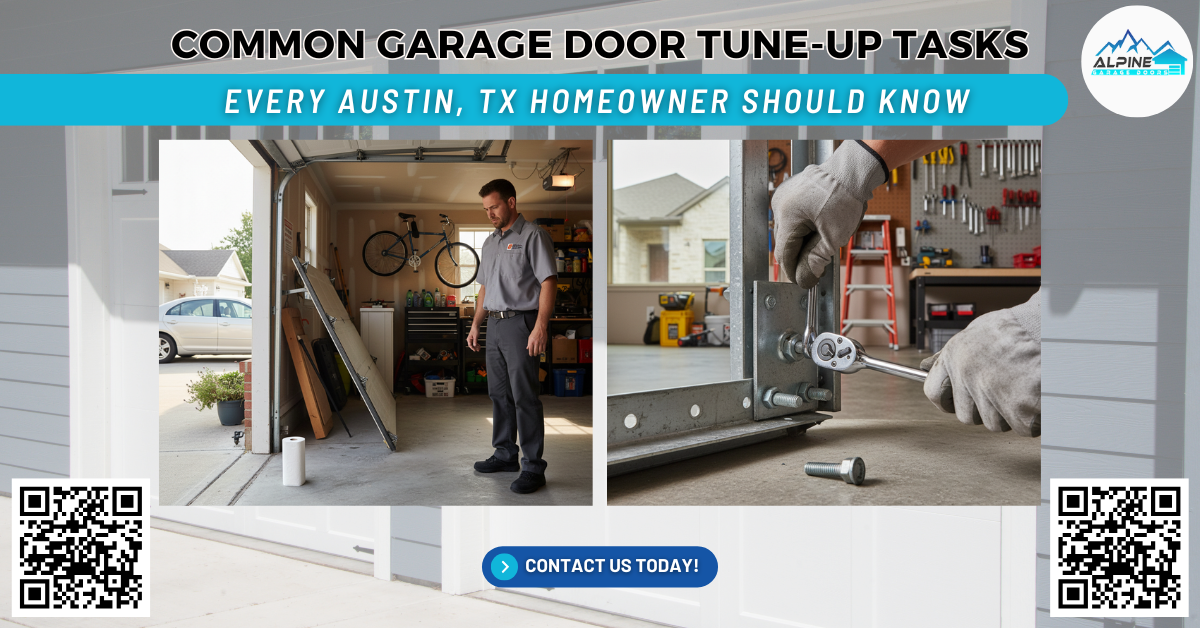One spring morning in Austin, a local homeowner noticed that her garage door was opening slower than usual. She also heard an unfamiliar grinding noise. Thinking it was just another hot Texas day, causing some friction, she ignored it. Days later, the door became completely stuck halfway open, leaving her car trapped inside and exposing her home to potential security threats. A visit from a professional garage technician revealed that her door system had not received a tune-up in years. The rollers were worn down, the opener was overworked, and the springs were stretched beyond their limit. What could have been a routine garage door tune-up turned into a more expensive repair project that could have easily been avoided.
According to the International Door Association, the average residential garage door opens and closes over 1,500 times each year. Each movement involves a complex network of components, including springs, rollers, cables, tracks, and the opener system. Without regular maintenance, these parts experience natural wear and tear, often leading to performance issues or even complete failure. The garage door is one of the most frequently used and largest moving systems in any home, yet it is often the most overlooked when it comes to maintenance.
Understanding the importance of a garage door tune-up is essential for every homeowner in Austin, TX. Whether your home has a single-door setup or a large multi-door garage, regular inspection and professional tune-up services ensure reliable operation, improved safety, and long-term cost savings. In this guide, Alpine Garage Doors Texas will walk you through all the common tune-up tasks you should know about, explain why they matter, and show you how professional service can protect your garage investment for years to come.
The Importance of Regular Garage Door Tune-Ups in Austin’s Climate
The weather in Austin is known for its extremes. Hot summers, humid air, and the occasional freeze can have a significant impact on your garage door system. Metal components expand and contract with temperature shifts, which causes stress on springs and alignment issues in the tracks. Humidity can cause rust, affecting rollers, hinges, and bearings. As time goes on, small issues evolve into major problems if not addressed through regular garage door maintenance.
Regular garage door tune-ups are not just about convenience. They are an essential part of home safety and long-term cost efficiency. By performing annual or biannual inspections and minor adjustments, you reduce the likelihood of breakdowns, improve energy efficiency, and increase the lifespan of your garage door components. Homeowners who neglect tune-ups often face sudden malfunctions, noisy operation, or expensive repairs that could have been avoided with timely attention.
For instance, a homeowner in Central Austin had an older garage door opener that began to emit high-pitched noises. After an inspection, we discovered that the lack of lubrication on the chain drive and worn-out gear teeth were causing the noise. A complete replacement was necessary, but if a tune-up had been scheduled earlier, simple lubrication and minor gear repair would have been sufficient.
Conducting a Thorough Visual Inspection
A garage door tune-up should always begin with a complete visual inspection. This step helps identify early signs of damage or wear in the door system.
Key Areas to Inspect:
- Tracks: Check for dents, warping, or loose alignment. Bent tracks can prevent rollers from moving smoothly and can increase stress on the opener.
- Rollers: Look for cracks in nylon rollers or signs of wear on steel ones. Damaged rollers can cause jerky or noisy door movement.
- Springs: Examine torsion and extension springs for rust, stretching, or gaps. Worn springs are dangerous and should be replaced by professionals.
- Cables: Look for fraying, rusting, or loose strands. Cable damage compromises safety and balance.
- Hinges and Hardware: Inspect hinges, screws, and brackets for corrosion or loosening. Misaligned hardware can lead to uneven lifting and noisy operation.
Homeowners can conduct these visual inspections periodically, but any unusual signs should prompt a visit from a trained garage door technician to avoid accidents or further deterioration.
The Role of Lubrication in Garage Door Longevity
Lubrication is one of the most critical and easiest tasks in garage door maintenance. Proper lubrication reduces friction between moving parts, ensuring quiet operation and extending the life of essential components.
Components That Require Lubrication:
- Springs: Applying garage door lubricant helps maintain elasticity and smooth lifting.
- Hinges: Lubricated hinges allow seamless pivoting and reduce grinding noise.
- Rollers: Metal rollers benefit greatly from lubrication, while nylon rollers should only have the bearings lubricated.
- Bearing Plates: Keeping bearings lubricated ensures the torsion system operates efficiently.
- Locking Mechanisms and Moving Joints: These also benefit from light lubrication to prevent stiffness and rusting.

Using a silicone-based or lithium-based lubricant specifically designed for garage doors is essential. Avoid using WD-40, as it is a cleaner and not a long-term lubricant. In Austin’s dusty climate, lubricating every six months helps keep your garage door system in top condition.
Tightening and Adjusting Loose Hardware
Garage doors are composed of many small parts that endure constant vibration during operation. Over time, these vibrations loosen bolts, nuts, and screws.
Key Tune-Up Steps:
- Use a socket wrench to tighten all fasteners, especially those on brackets, hinges, and roller tracks.
- Check for loose rail supports or motor mounting brackets in opener systems.
- Confirm that garage door hinges are tightly connected and not cracked or worn.
Even one loose bolt can throw the entire system off balance, leading to costly repairs. Taking the time to perform this step during every garage door tune-up is essential for smooth operation and overall safety.
Testing Garage Door Balance and Spring Tension
A balanced garage door ensures that the opener does not bear the full weight of lifting the door. If the springs are unbalanced, the opener works harder and wears out faster.
How to Test Door Balance:
- Disconnect the opener by pulling the emergency release cord.
- Manually lift the door halfway and release it.
- If the door remains in place, it is balanced. If it drops or rises quickly, the springs are improperly tensioned.
Adjusting springs is a dangerous task and should never be attempted without the right tools or experience. If your garage door is unbalanced, contact a local professional technician to safely recalibrate or replace the springs. Timely service helps you avoid broken springs and unexpected system failure.
Inspecting Weather Seals and Insulation for Energy Efficiency
In Austin’s climate, keeping your garage well-insulated improves energy efficiency and comfort. The bottom seal and perimeter weather stripping on your garage door play a vital role in temperature control and pest prevention.
Tune-Up Tips:
- Check for gaps, cracks, or brittleness in the weather seal.
- Examine the side and top seals for signs of wear.
- Inspect foam or panel insulation on the inside of the garage door.
Replacing worn weather stripping is a simple, low-cost task that prevents moisture, dust, and rodents from entering your garage. It also helps maintain a stable internal temperature, which is especially important if you use your garage as a workspace or laundry area.
Cleaning Tracks and Maintaining Rollers
Dust, debris, and grime are common in Austin garages. Over time, these materials collect in the garage door tracks and hinder smooth operation.
Cleaning Guidelines:
- Use a shop vacuum or brush to remove debris from the tracks.
- Wipe the inside of the track with a damp cloth.
- Avoid lubricating the track itself, as grease can attract more dust and cause buildup.
Rollers should spin freely. If you hear squeaking or feel resistance, clean the roller and lubricate the bearing. Worn or flat-spotted rollers should be replaced promptly to prevent jerky motion and strain on the opener.
Garage Door Opener Testing and Maintenance
The garage door opener is the brain of your garage door system. It controls lifting, remote functionality, and safety features. Routine maintenance ensures reliable performance and extends the life of the motor and drive system.
Tasks to Perform:
- Test remote controls and wall units for responsiveness.
- Listen for unusual grinding or buzzing sounds during operation.
- Examine the chain or belt drive for proper tension.
- Replace weak or expired batteries in remotes and keypads.
In one case in North Austin, we discovered a homeowner’s opener would delay opening for several seconds. The issue was traced back to a stretched belt drive. Quick maintenance resolved the problem, preventing premature wear on the motor.
Checking and Testing Safety Sensors
Safety sensors prevent the garage door from closing on objects, pets, or people. Properly working sensors are crucial for families with children or pets.
Testing Procedure:
- Clean the sensor lenses with a soft cloth.
- Make sure both sensors are aligned with steady green lights.
- Place an object, like a cardboard box, in the door’s path and close the door.
- The door should automatically reverse upon contact.
If the door does not reverse, the sensors may be misaligned or malfunctioning. Immediate professional attention is necessary to restore safe operation. Safety features are not optional—they are critical to preventing injury and damage.
Testing Auto-Reverse Force Settings
The auto-reverse feature ensures the garage door will reverse when it meets resistance. This function is mandated by modern safety standards and should be tested regularly.
How to Perform the Test:
- Close the garage door using the remote.
- As the door descends, place your hand on the bottom edge and apply upward pressure.
- If the door does not immediately reverse, the force setting is too high.

Incorrect force settings can damage property or injure someone. A professional garage technician can quickly adjust the opener’s sensitivity to the manufacturer’s recommended level, restoring safe function.
When to Call for Professional Garage Door Services
While homeowners can perform many garage door maintenance tasks themselves, some components require technical knowledge, the right tools, and experience to handle safely.
Call a Professional When:
- Springs are stretched, broken, or noisy
- Cables appear worn, frayed, or misaligned
- The door is off-track or unbalanced
- Sensors or openers stop functioning
- You hear loud pops, screeches, or grinding
- The garage door reverses for no reason
Choosing a professional garage door service company in Austin ensures every aspect of your system is examined and tuned with precision. Look for local companies that offer same-day service, a free quote, and knowledgeable technicians who can answer your questions and provide transparent pricing.
How Can Alpine Garage Doors Texas Help You?
At Alpine Garage Doors Texas, we specialize in providing dependable, expert garage door services for homeowners throughout Austin and surrounding communities. Whether you need a full garage door tune-up, emergency garage door repairs, or want to replace your opener, our team is equipped to handle all garage door systems with professionalism and care.
📍 Visit us at: 638 Saddle Rock Dr, Houston, TX 77037
📞 Call now: 346-438-1138
We offer same-day tune-up services, detailed inspections, spring and cable repairs, garage door opener troubleshooting, and complete door replacement for both residential and commercial properties. Our technicians have years of experience servicing all major brands, including LiftMaster, Craftsman, and Chamberlain.
If you have a few questions or are unsure about your garage project, contact our friendly team for guidance or a no-obligation estimate. We are proud to be your trusted partner for routine maintenance, garage door repair, and full system upgrades. Let us help keep your garage door in peak condition all year round.
Final Thoughts
A garage door tune-up is one of the smartest home maintenance tasks any Austin homeowner can perform. From safety sensors to spring balance, every part of the garage door system plays a crucial role in daily reliability and safety. Regular maintenance not only improves performance but also prevents costly repairs, extends the lifespan of your system, and protects your home.
By following a routine maintenance schedule and reaching out to qualified professionals when needed, you ensure that your garage door continues to serve you smoothly and safely for many years. Remember, minor issues caught early cost far less to fix than major system failures. Whether you’re dealing with a noisy opener, worn rollers, or a misaligned track, Alpine Garage Doors Texas is here to help with top-notch service, clear pricing, and expert guidance.
Take the next step in protecting your home. Schedule your professional garage door tune-up today and experience the difference that routine care and expert service can make.
Frequently Asked Questions (FAQs)
- How long does a typical garage door tune-up take?
A standard garage door tune-up usually takes between 45 minutes to an hour for a professional technician. More complex issues, like adjusting spring tension or replacing components, may extend the service time slightly.
- Can I perform a garage door tune-up myself without professional help?
While basic tasks like cleaning tracks and lubricating parts can be done as a DIY project, anything involving springs, cables, or the opener system should be handled by a trained technician for safety reasons. Improper handling can lead to injury or further damage.
- How often should I schedule a garage door tune-up?
It is recommended to schedule a professional garage door tune-up at least once a year. Homes with high garage door usage may benefit from semi-annual inspections and maintenance to avoid unexpected problems.
- Will a tune-up fix a noisy garage door?
Yes, in many cases, a tune-up can significantly reduce or eliminate noise caused by dry rollers, loose hardware, or unlubricated hinges. However, if the noise stems from worn-out components, replacement may be necessary.

